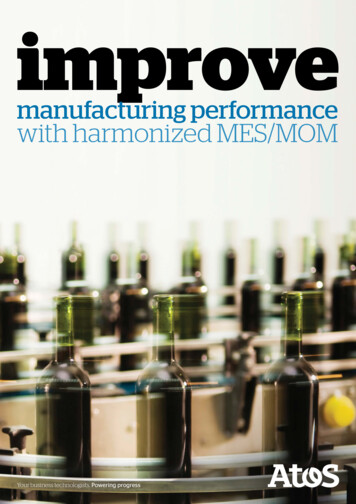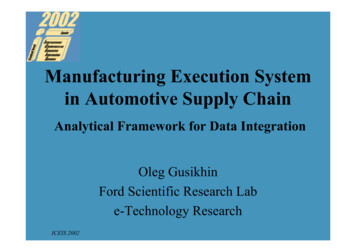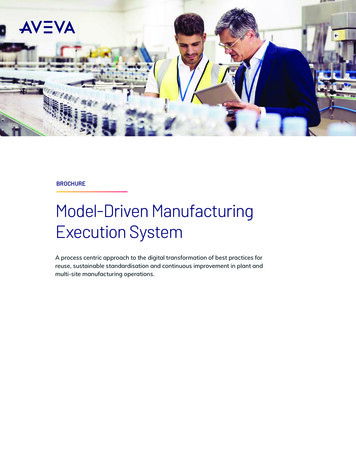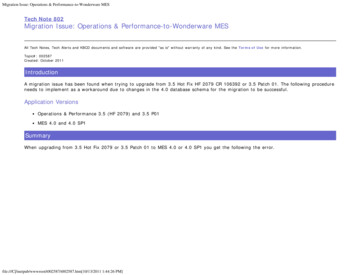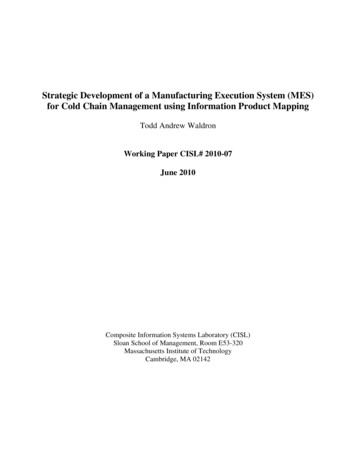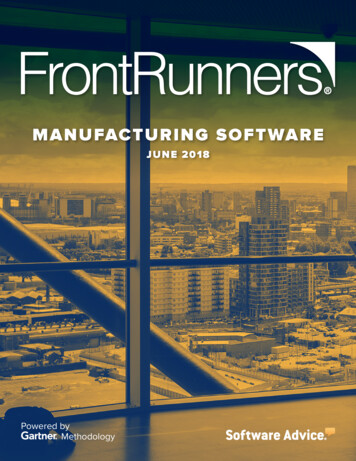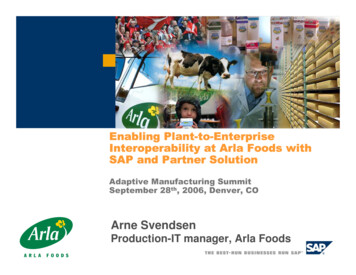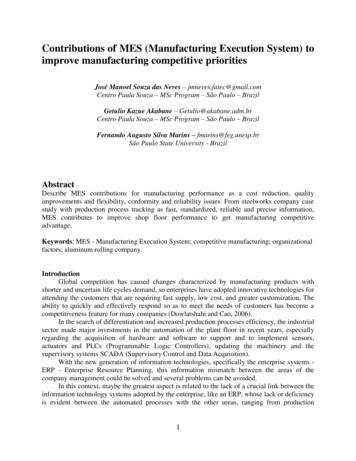
Transcription
Contributions of MES (Manufacturing Execution System) toimprove manufacturing competitive prioritiesJosé Manoel Souza das Neves – jmneves.fatec@gmail.comCentro Paula Souza – MSc Program – São Paulo – BrazilGetulio Kazue Akabane – Getulio@akabane.adm.brCentro Paula Souza – MSc Program – São Paulo – BrazilFernando Augusto Silva Marins – fmarins@feg.unesp.brSão Paulo State University - BrazilAbstractDescribe MES contributions for manufacturing performance as a cost reduction, qualityimprovements and flexibility, conformity and reliability issues. From steelworks company casestudy with production process tracking as fast, standardized, reliable and precise information,MES contributes to improve shop floor performance to get manufacturing competitiveadvantage.Keywords: MES - Manufacturing Execution System; competitive manufacturing; organizationalfactors; aluminum rolling company.IntroductionGlobal competition has caused changes characterized by manufacturing products withshorter and uncertain life cycles demand, so enterprises have adopted innovative technologies forattending the customers that are requiring fast supply, low cost, and greater customization. Theability to quickly and effectively respond so as to meet the needs of customers has become acompetitiveness feature for many companies (Dowlatshahi and Cao, 2006).In the search of differentiation and increased production processes efficiency, the industrialsector made major investments in the automation of the plant floor in recent years, especiallyregarding the acquisition of hardware and software to support and to implement sensors,actuators and PLCs (Programmable Logic Controllers), updating the machinery and thesupervisory systems SCADA (Supervisory Control and Data Acquisition).With the new generation of information technologies, specifically the enterprise systems ERP - Enterprise Resource Planning, this information mismatch between the areas of thecompany management could be solved and several problems can be avoided.In this context, maybe the greatest aspect is related to the lack of a crucial link between theinformation technology systems adopted by the enterprise, like an ERP, whose lack or deficiencyis evident between the automated processes with the other areas, ranging from production1
management (Programming and Production Control, Logistics, Supply), the purchasing area, aswell the financial and the human resources areas.A solution to solve this lack of communication between the productive area and the ERP isto adopt the MES - Manufacturing Execution System that provides the necessary links toimprove these relevant relationships, and improving the manufacturing process competiveness.Unfortunately there is few published works on the contributions of the MES system use,and this paper is focused on this literature gap. This way, this research was developed with theintention of contributing to the knowledge expansion about the process of implementing theMES, and how it improves the competitive dimensions of manufacturing. The research alsoaimed to analyze what organizational factors can support the MES implementation, and for thatit is presented a case study in an aluminum rolling company.So, in short, this paper has aimed answering the following questions: What is thecontribution of the implementation of the MES information technology to improve thecompetitive priorities of manufacturing? How did the organizational factors contribute to theimplementation of the MES? To what extent the MES contributes to the competitive priorities ofmanufacturing?The paper is organized as follows: a short background on Information Technology Systemsand, in particularly on ERP and MES, is presented, and in the sequence are described theresearch method and the case study in an aluminum rolling company; finally are commented theresults and are suggested future works related to the theme.BackgroundSeveral studies discussed the implementation of the ERP in several kinds of companies,focusing on its advantages, difficulties to its absorption by the professionals, critical successfactors, impacts into the organization and its collaborators, the relationship of the IT with thebusiness strategy, the increase of the competitive potential of the companies, and also thepossibilities for adopting it in small and medium enterprises (Al-Mashari and Al-Mudimigh,2003; Bendoly and Schoenherr, 2005; Gupta 2000; Nicolaou, 2004).Some related applications on Information Technology (IT) Systems literature have gainedimportance in the business area. So, technologies such as CNC, CIM, MRP and MRPII, andCAD/CAM systems are the main examples, and they are leading the companies, where they weredeployed, to a qualitative leap and competitiveness advantages in the global market. Particularly,in the manufacturing area, the efficient and effective work as well as the use of informationbecame essential for an economic vitality and growth of the enterprise (Molina and Santaella,2006).Several providers offer MES systems in the market, which are suitable according to thecompany needs. They are used in enterprises that already have ERP systems as well assignificant automated processes on the plant floor that will be integrated into the MES system.The MES system ensures a more efficient management because it allows decision makingbased on relevant, current and reliable information, allowing you to check what is happening inthe manufacturing company. The MES also consolidates the planning and the mapping to theimplementation of all production stages, processing applications connected to the control of theproduction systems, optimizing the production processes, democratizing information andintegrating information, and in this way the MES provides a global view of production area andin real time.2
Figure 1 shows the desirable schematic view which comprises the integration, the MES,the various organizational levels, from plant floor to business management.SSMERPSCMMESP/PEMES – Manufacturing Execution SystemSSM – Sales & Service ManagementSCM – Supply Chain ManagementManagementERP – Enterprise Resources PlanningP/PE – Product and Process EngineeringControls – PLC, CSS, line and machine controlControlsFigure 1 - The integration of MES among plant floor ITs and Enterprise Management SystemsSnoiej (2006)According to Hayes and Wheelright, (1984), manufacturing companies have establishedtheir business strategies based on a hierarchical structure. As an example, the operationalstrategy arises from the need to meet the functional strategies that, in the case of themanufacturing area, generate competitive priorities to cope with the market needs (Santos,2000).Each of the company's strategic areas was embedded with the IT solutions to improve itsefficiency and reach its goals. The main feature of these information technologies is to supportthe fulfillment of the functional areas objectives. So, technologies such as CAD, CAM, CAE,EDI have supported the competitive priorities of manufacturing, the ERP systems have providedthe business management strategy.Company StrategyERPCompetitive StrategyBusinessStrategyFunctional nufacturingStrategyFinanceStrategyOperational StrategyCompetitivePriorities ofManufacturingMESCAD, CAM,CAE, Robotics,EDIFigure 2 - Integration of business management strategies with the priorities of manufacturingfrom the IT systems and MES - Adapted from Hayes e Wheelright , (1984)Figure 2 shows the structure of the company's strategies and the acting of the various ITsolutions, it should be observed that the IT resources used in functional areas, such as in themanufacturing area, do not generate available information to the top management. The someoccurs with IT solutions for management business that do not reach to manufacturing. The MES3
system fills this gap, involving all functional areas, and integrating the plant floor to the top ofmanagement level of the company.The MESA - Manufacturing Execution Systems Association International -, an associationof companies which provide integrated MES system, has defined as a system that generatesinformation and facilitates the optimization of production activities since the costumer order tofinished product.Kall (1999) and Choi et al (2002) define the MES, as a functional layer that integrates ERPsystems and controls the plant floor in order to manage the manufacturing production planning ina feasible manner. MES fills the gap between the ERP system and the automated systems on theplant floor.According to Blackstone Jr. and Cox III (2004), the MES is a system of information andcommunication for the production environment of a company. The MES has the purpose tomonitor and to improve all aspects which influence the production process, in order to achievehigh flexibility of production, as well as low production costs. It has also important features suchallows production records, production reports, product tracking and details of the planning andscheduling process.For Hwang (2006), the MES is a process information system that collects data, processesand analyzes materials, semi-finished and finished products, equipments, time and cost, at theproduction site in real time, i.e. it monitors the work while it is occurring. Concluding, the MESsystem operates as a hub for distribution of data on the plant floor to all the other enterprisesystems.The MES system include an information center composed of 11 elements or functions (seeFigure 3), which are joined to other databases. These include the main functions of the MES(Hwang, 2006; Kletti, 2007; Snoeij, 2006; Yu et al., 2009). The central idea is to measure inorder to control so the performance indexes are used to compare the results of the productionlines within the same plant, company or with other known results.Operations andDetailedSequencingResourceAllocationsand ductTracking dAcquisitionQualityManagementFigure 3: Schematic of relationship between the various functions ofMES - Snoij (2006)4
The functions shown in Figure 3 are integrated with sales and services (MSS), supply chainmanagement (SCM), enterprise management system (ERP), Engineering (PPE), and controls,which can generate the mechanisms for production management by means a fully computerizedinformation, in a quick, safe and reliable way for the company (Vinhais, 1998; Hwang, 2006).The integration of the management system with the operating systems is crucial for thecompanies whose primary business is the manufacture, since the key information such asfinancial activities and accounting, inventory management and asset management, are taken fromthe plant floor date.MethodIn this research goals were to investigate the implementation of the MES system in theproduction process of an aluminum rolling company and to assess the resulting improvement ofthe competitive priorities of manufacturing having as supporters the organizational factors.The method of case study concerns the study of a problem seen through multipleperspectives and in its original context. The research was conducted by the method single casestudy, and the object of study consisted of a multinational company, market leader in aluminumproducts.The main way of collecting data was through semi-structured interviews, additionally, theresearch method included visits to the factory and plant floor observation. Internal documentswere consulted and selected to elaborate the questions for the interviews.Case studyThe studied company is a multinational, market-oriented and global leader in rolledaluminum with respect to revenue, production volume and market share. Company has itsheadquartered in Atlanta - USA, and through its subsidiaries and affiliates located in Asia,Europe, North America and South America in the areas of mining of bauxite, alumina refining,power generation, production of primary aluminum, in rolled aluminum and aluminum recycling,as well as it has invested in research and technology.It is a leading global supplier of aluminum rolled products, the largest single buyer ofaluminum and the world leader in aluminum recycling, has a presence in four continents, 11countries, with 34 operating units, and approximately 12,900 employees worldwide. Thecompany is the largest on laminates in the world and one of the biggest producers of primaryaluminum in Asia.The productive capacity of its plants is divided into the following main products: plates,sheets, discs, sheets, billets, and finishing chemicals, beverage cans, household utensils, civilconstruction, and in the automotive, transportation and packaging segments.The interviews ware conducted with seven professionals of the studied company, withgreat experience and involved in the implementation of MES.Problems of the studied company and MES implementationThe implementation of MES in the studied company began in the early 2005 in theremelting area, but effectively began operating in 2006. The MES was implanted, at the sametime, in three production lines for plates and recycling products in order to provide a uniquesolution for the plant.5
Considering the cold mill, the MES project started in 2007, and its operation at the plantbegan in October 2008. The MES replaced the existing system that was based on an Oraclesystem; its implementation is still running and it is being made in a web environment.There was an interest in the area of remelting in the installation of the MES, because thesector is very much automated and works with very large machine cycles, with at least 2 to 4hours each. Particularly the hot-rolling mill requires that several variables that have to be set inorder to have more stability in the final product.It was verified that the problems like lack of an adequate interface with the automationresources, the need of performing nonconformity tests and the defect analysis, among otherproblems were creating many difficulties and complexity for the operator. With the MES, theoperator can insert information data in the system without too much difficulty and withoutspending a long time, in fact all areas started to have facilities for real time analysis, as forexample informing whether the forecasted production time was used or whether some productnonconformity was observed in the period.The remelting area is responsible by the process, its reliability and the people training.There was already an automation structure focused on the process, but machine interruptions hadoccurred and the information, like the stop machine indicators, of these facts were not accurate.In the metallurgical process cycles there is the need of giving to the metal a rest during sometime, depending on the its size, kind of alloys, or even depending of its position on theproduction list. The cold rolling mill needs a lot of information such as chemical compositionlimits of thickness and width, as well as a lot of information for each batch to be produced.Often, the equipment requires around 20 to 30 different parameters to machine setup in order tomake a specific product, and it is very difficult to machine operators perform a manual dataentry.The remelting area produces in batches, not in a continuous process, and a productionorder comes from the customers needs. The ERP chooses which line will be used formanufacturing the product and what product characteristics, while the MES contributes with theinformation where is located the product (which furnace stage) and information on which will bethe next product to manufacture. The MES does not choose the product position in themanufacturing order, but it monitors the progress of the manufacturing order chosen. Monitoringthe operators’ decisions, it checks if the batch has satisfied the efficiency standards, and if thisdoes not occur it reprograms the production in order to increase the efficiency over time.In the hot-rolling area, the existing manufacturing modules of the ERP were withoutappropriate adjustments, and so they did not meet the information needs and the appropriatedintegration level with automation. Therefore, for it be able to provide the same MESfunctionality, and offer the same level of integration with the automation, several adaptationswould be necessary.The implementation of the MES enabled increased accuracy of the input data on the ERP.One example was the production of monthly closings, which was made very slowly and,therefore, the production data and the observations on the process in real time made by theoperators that could avoid production errors are sometimes lost.Final considerationsThis section reports the results of the performed qualitative research based on theoreticalaspects and the case study. In this section it are presented the improvements observed in the6
studied company areas with respect to their competitive priorities of manufacturing, as well asare identified the organizational factors that can adequately support a MES implementation.In the theoretical framework available in the literature, seven competitive priorities ofmanufacturing were identified (Costs, Quality, Delivery, Flexibility, Reliability, ProductConformity, and Manufacturing & Strategic Business Integration). These priorities, and theactions that are implemented by the company areas, are tacitly established between theemployees and the managers in the studied company, i.e., produce the set out quantities (andachieve the goals) have precedence in relation to these priorities.Interviews with those managers responsible for the manufacturing areas shown that theconcern for cost reduction and conformity attendance were clear, it also showed that had a largeintegration in the manufacturing by means of the use of IT resources. In fact, the whole managerstraining process and their involvement in the design and the implementation of MES, it wasmade by the manufacturing area, by the IT department, and by the MES developer (external).There was a significant decrease in gas consumption in the remelting area, not only by theperformance of the MES, but also by other lean manufacturing tools applied. With the doublechecking of the data entry of raw materials made by the operators and verified by the MESsystem, there was a reduction of the non-conformity of the manufactured products. Thisreduction increased the reliability of the area, and through a data log of product manufacturing,enabled the tracking of the whole process in a retroactive period of up to two years. With thereduction of failures in the setup of the equipment, the quality of the product area had asignificant improvement. Table 1 shows these improvements in the remelting area.Table 1 – Improvement of competitive priorities in the remelting areaPriorityRemeltingObservationsCostsa) Reduced consumption of natural gas The reduction was also due to(Approximately 5%). Natural gas is the the implementation of othersecond largest cost to the company.quality tools with the MES thatb) Rework reductioncontributed to the reduction ofgas.Qualitya) Reduction of failures in the setup. Only contribution of MES inb) Reduction of errors in the introduction into order to implement doublethe furnace of the chemical composition of checking.the plates.DeliveryThere was no change.FlexibilityIncreased the flexibility of changing aOnly contribution of MESproduction line to another.Reliabilitya) Registration data are available online, with Only contribution of MESthe possibility of tracking the entire process.b) More transparent informationProductReduction of non-conforming signs.The reduction was also due toConformitythe implementation of otherquality tools with the MES.ManufacturingExisting in the whole process. It is essentialintegration with for business.strategicbusiness7
The hot-rolling mill area had as its goals the reduction of the production costs andimproving the productivity with the implementation of MES, as well as could obtain a betterlineup of the equipment with a consequent reduction of gas consumption. There was also asignificant reduction of rejection in the products leaving the mill, and with the reducing the setuptime from 10 to 15 seconds per product (plate) was increased the area productivity and itsflexibility. The best ability to track and control the production, in addition to the onlineavailability of performance indicators (charts, productivity, and use level) quickly led to a greaterreliability in the area. Table 2 shows the improvements with the implementation of the MES inthe hot-rolling mill of the studied company.Besides that, in the hot-rolling mill area, it was performed a further study on theimplementation of the MES, which offer more accurate quantitative information on thecompetitive priorities of manufacturing. In an interview with the hot-rolling mill manager, it wasobserved that there was a reduction in gas consumption in the transformation process of theplates coming from the remelting area.After the implementation of the MES, it was reduced the use of gas from 24.4 m³ per ton ofcoil production to 23.7 m³ in the first year, and to 22.6 m³ in the second year. These numbersshow a total reduction of 252,070 m³ of gas use in the first year of implementation of MES, andof 690,120 m³ in the second year. This reduction generated savings values of US 68,500 on thefirst year and of US 188,000 on the second year.Table 2 - Improvement of competitive priorities in the area of hot rolling areaPriorityHot-rolling millCostsa) Better furnaces scheduling, gas consumption reduction.b) Elimination of discards in the wrong setup for the reverserolling mill.c) Reducing the time of data appointment for operators(1.5 min/pointer/plate).Qualitya) Reduction of rejection in the reverse rolling mill. 1.7% to 0%rejection.b) Improving the quality of information on the plant floor.DeliveryThere was no change.FlexibilityReduced setup time from 10 to 15 second per card laminated.ReliabilityTraceability and control of production, besides the onlineavailability of the performance indicators (charts, productivity,use level) more quickly.ProductReduction of coils nonconforming.ConformityManufacturing Existing in the whole process.integrationwith strategicbusinessObservationsImprovementsachieved onlywith theimplementationof MESWith the implementation of MES in the setup of scalping machine, the time was reducedfrom 6 to 5 hours, and this reduction is due to the automatic registers allowed by the MES,before these registers were made manually by the operator.Since the MES implementation, the hot-rolling mill began to receive data on the productsto be laminated, performing automatically the equipment setup and significantly reducing thepossibility of errors, in fact there were no further rejections due to setup. Besides the8
improvement of competitive priorities of manufacturing, it was unanimously reported by thethree areas that a great gain was the possibility of tracking the entire process, from the itsbeginning (receive the product orders) including the handling of raw material (remelting area),the finished products manufacturing (hot-rolling mill and cold mill areas), and the final deliveryto the customers.Conclusions.The few studies, available in the scientific literature, did not characterize the importanceof the MES systems for the manufacturing area, and they showed that, in general, theimplemented MES systems have not relationship with the enterprise management systems.During this research, it was evident the fact that ERP is not a system designed to help in themanufacturing process improvements, mainly the automated and computerized processes of theplant floor.The case study also allowed verifying that the implementation of the MES in the studiedcompany improved the competitive priorities of the productive areas, as well as allowedidentifying the organizational factors, which can support this implementation.A relevant contribution of this research was increasing the perception of the MES as asystem of integration of manufacturing with the system of business management. The vision ofthe consulted areas of the studied company showed the importance of the MES system related tothe reliability of the information about production processes and the information disseminationacross the functional areas of the ERP.The MES was identified to be a complement to ERP systems and focused on themanufacturing areas allowing have traceability on their processes. In fact, this research showedthat traceability can be a competitive advantage for the company because, with it anyone canimmediately identify the entire route of a given product, from raw materials coming fromsuppliers to the final product sent to the client. Additionally, this ability to track the productposition by the Web allows the final client knows where is your order.By the case study, it was found that several organizational factors were important tosupport the implementation of MES, such as: organizational culture, organizational learning,teamwork and training. Also it was observed that in all implementing process, the support ofsenior management was very significant to secure funding the acquisition system (including theinterfaces, the hardware and the people training) that allowed obtaining the returns on theinvestment due to the performance improvements.Therefore, the IT resources of the company, including the MES, should be integrated withthe company's business organization to ensure efficiency and the achievement of strategicobjectives.In the case study, for the successful implementation of the MES and to reduce the impactson the people who were directly connected to the system, it was fundamental the formation ofteams comprised by leaders and area operators who were responsible for the IT resources and theMES developer. These teams were multiplying in the areas where the MES was implementedcreating a value network to obtain positive results with the system implementation. Theobservations and results obtained using MES were converted into procedures and newknowledge for the company collaborators. Also these experiences meant that the company hascreated an own process of organizational learning in the implementation and in the use of MES.9
Other contributions to the business generated by this research are linked to the importanceof the MES for the manufacturing area and its importance in integrating with the business andthe organization.The case study had shown the improvement of productivity with the MES and thereliability of data and information available. The possibility of having a digital database allowedthe traceability of the products. With the support of WEB technology, the company can comparethe projected manufacturing time with the real-time obtained, and with these information canimprove the decision making process on manufacturing and the equipment utilization.Usually, the MES consolidates the planning and maps all production stages, it allowsimproving the production processes, and the MES disseminates reliable and importantinformation, integrating the factory as a whole and in real time.References:AL-MASHARI, M.; AL-MUDIMIGH, A., ERP implementation: lessons from a case study, Information Technology & People,v. 16 No. 1, pp. 21-33, 2003.BENDOLY, E.; SCHOENHERR, T., ERP system and implementation-process benefits Implications for B2B e-procurement,International Journal of Operations & Production Management, Vol. 25 No. 4, pp. 304-319, 2005.BLACKSTONE JR, J. H; COX III, J. F. III, APICS Dictionary, 11 ed, Alexandria, 2004.CHOI, B. K., KIM, B. H., MES (Manufacturing Execution System) architecture for FMS compatible to ERP (enterprise planningsystem), International Journal of Computer Integrated Manufacturing, vol. 15, NO. 3, 274–284, 2002.DOWLATSHAHI, S.; CAO, Q., The relationships among virtual enterprise, information technology, and business performancein agile manufacturing: An industry perspective, Division of Business Administration, HW Bloch School of Business andPublic, European Journal of Operational Research, n. 174, 835–860, 2006.GUPTA, A., Enterprise resource planning: the emerging organizational value systems, Industrial Management & DataSystems, v.100/3, p.114-118, 2000.HAYES, R. H.; WHEELRIGHT S. C., Restoring our competitive edge: competing through manufacturing. New York: JohnWiley, 1984.HWANG, YD., The practices of integrating manufacturing execution system and six sigma methodology, International Journalif Advanced Manufacturing Technology, n. 30: pg. 761-768,2006.KALL, J., Manufacturing Execution Systems: Leveraging Data for Competitive Advantage, Quality Digest, vol. 19(8), pg.31-34, ago, 1999.KLETTI, J.(Org.), Manufacturing execution system – MES, Springer, Mosbach, 2007.MOLINA, A., SANTAELLA, A. R., Achieving e-Manufacturing: multihead control and web technology for the implementationof a manufacturing execution system, Journal of Intelligent Manufacturing, vol 17: p. 715–724, 2006. DOI10.1007/s10845-006-0040-2.NICOLAOU, A. I., Firm performance effects in relation to the implementation and use of enterprise resource planning systems,Journal of Information Systems, v18 i2 p79(27), Fall 2004.SANTOS, F. C. A., Integration of human resource management and competitive priorities of manufacturing strategy.International Journal of Operations and Production Management, v.20, n.5, p.610-628, 2000.SNOEIJ, J., MES Product Survey 2006, LogicaCMG, MESCC – Manufacturing Execution System Competence Center,Arnhem, 2006.VINHAIS, J. A., Manufacturing execution systems: the onestop information source. Quality Digest, vol. 18(9), p. 39–40, set,1998.YU, W.; XIAO-DONG, X.; CONG-XIN, L., Modeling Research on Manufacturing Execution System Based on Large-scaleSystem Cybernetics, Journal of Shanghai Jiaotong University (Science), Shanghai Jiao Tong University Press, vol.13(6),
1 Contributions of MES (Manufacturing Execution System) to improve manufacturing competitive priorities José Manoel Souza das Neves - jmneves.fatec@gmail.com Centro Paula Souza - MSc Program - São Paulo - Brazil Getulio Kazue Akabane - Getulio@akabane.adm.br Centro Paula Souza - MSc Program - São Paulo - Brazil Fernando Augusto Silva Marins - fmarins@feg.unesp.br
